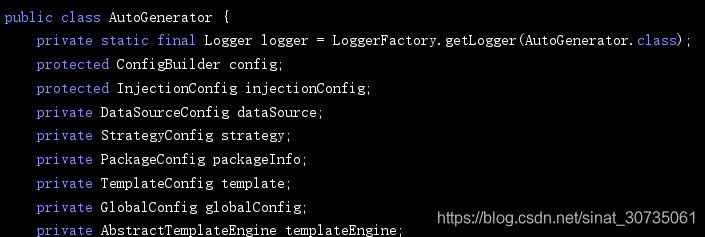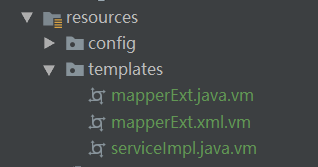阅读提示
具有mybatis基础,熟练使用mybatis-plus。
概述
我们都知道,mybatis-plus是一个mybatis的增强工具,为简化开发、提高效率而生,我们经常使用mybatis-plus生成controller、service、mapper等文件,对于简单的curd,可以直接使用mybatis-plus封装好的方法。
然而,我们经常有这样那样的需求,需要额外编写sql实现,如果直接在mapper.xml文件中编写,一旦数据库表结构改动需要重新生成文件就悲催了,不得不花大量精力修改代码。所以,这里介绍一种方式,自动生成mapper扩展文件,我们自定义编写的程序存放在扩展文件中,这样在数据库表结构改动时,不用担心程序会被覆盖,也不用修改代码。
mybatis-plus版本
|
1
2
3
4
5
6
7
8
9
10
11
12
13
14
15
|
<dependency>
<groupId>com.baomidou</groupId>
<artifactId>mybatis-plus-boot-starter</artifactId>
<version>3.2.0</version>
</dependency>
<dependency>
<groupId>com.baomidou</groupId>
<artifactId>mybatis-plus-generator</artifactId>
<version>3.2.0</version>
</dependency>
<dependency>
<groupId>org.apache.velocity</groupId>
<artifactId>velocity-engine-core</artifactId>
<version>2.1</version>
</dependency>
|
mybatis-plus生成mapper扩展文件
熟悉mybatis-plus的朋友都知道,mybatis-plus提供了一款代码生成器,可以自动生成代码,我们就从这款代码生成器入手。
代码生成器配置完毕后,运行时会执行 AutoGenerator.execute() 方法,我们先看看这个东东
熟悉的GlobalConfig、DataSourceConfig等等就不介绍了,我们关注的是InjectionConfig、TemplateConfig和ConfigBuilder。这里先讲述一下我们的思路:把ext文件通过配置直接生成,并保留mybatis-plus为service扩展的批量操作,我们需要三个文件,第一个文件生成ext.java,第二个文件生成ext.xml,第三个覆盖serviceImpl文件(保留mybatis-plus为service扩展的批量操作)
**************************干货来咯**************************
|
1
2
3
4
5
6
7
8
9
10
11
12
13
14
15
16
17
18
19
20
21
22
23
24
25
26
27
28
29
30
31
32
33
34
35
36
37
38
39
40
41
42
43
44
45
46
47
48
49
50
51
|
// 生成目录
public static final String OUTPUT_DIR = "项目路径/src/main/java";
// mapperExt目录
public static final String MAPPER_EXT = "ext目录";
// 模板配置,这里可以自定义模板路径,如果路径如下所示,则该部分可以省略
TemplateConfig tc = new TemplateConfig();
tc.setServiceImpl("templates/serviceImpl.java");
ag.setTemplate(tc);
// 自定义配置
InjectionConfig cfg = new InjectionConfig() {
@Override
public void initMap() {
Map<String, Object> map = new HashMap<>(10);
/// 这里可以在 VM 文件中用 ${cfg.MapperExt} 引用该值
map.put("MapperExt", MAPPER_EXT.replace('/', '.'));
this.setMap(map);
}
};
// 自定义输出配置
List<FileOutConfig> focList = new ArrayList<>();
focList.add(new FileOutConfig("templates/mapperExt.xml.vm") {
@Override
public String outputFile(TableInfo tableInfo) {
return String.format("%s/%s/%sMapperExt%s", OUTPUT_DIR, MAPPER_EXT, tableInfo.getEntityName(), StringPool.DOT_XML);
}
});
focList.add(new FileOutConfig("templates/mapperExt.java.vm") {
@Override
public String outputFile(TableInfo tableInfo) {
return String.format("%s/%s/%sMapperExt%s", OUTPUT_DIR, MAPPER_EXT, tableInfo.getEntityName(), StringPool.DOT_JAVA);
}
});
cfg.setFileCreate(new IFileCreate() {
@Override
public boolean isCreate(ConfigBuilder configBuilder, FileType fileType, String filePath) {
// 如果是 mapperExt、service、controller 文件,并且已存在则不创建
if (filePath.contains(MAPPER_EXT) || fileType == FileType.CONTROLLER || fileType == FileType.SERVICE || fileType == FileType.SERVICE_IMPL) {
if (new File(filePath).exists()) {
return false;
}
}
// 判断文件夹是否需要创建
checkDir(filePath);
return true;
}
});
cfg.setFileOutConfigList(focList);
ag.setCfg(cfg);
|
mapperExt.java.vm配置
|
1
2
3
4
5
6
7
8
9
10
11
12
13
14
15
16
17
18
19
|
package ${cfg.MapperExt};
import ${package.Mapper}.${table.mapperName};
/**
* <p>
* $!{table.comment} MapperExt 接口
* </p>
*
* @author ${author}
* @since ${date}
*/
#if(${kotlin})
interface ${table.mapperName}Ext : ${table.mapperName}
#else
public interface ${table.mapperName}Ext extends ${table.mapperName} {
}
#end
|
mapperExt.xml.vm配置
|
1
2
3
4
5
|
<?xml version="1.0" encoding="UTF-8"?>
<!DOCTYPE mapper PUBLIC "-//mybatis.org//DTD Mapper 3.0//EN" "http://mybatis.org/dtd/mybatis-3-mapper.dtd">
<mapper namespace="${cfg.MapperExt}.${table.mapperName}Ext">
</mapper>
|
serviceImpl.java.vm配置
|
1
2
3
4
5
6
7
8
9
10
11
12
13
14
15
16
17
18
19
20
21
22
23
24
25
26
|
package ${package.ServiceImpl};
import ${package.Entity}.${entity};
import ${cfg.MapperExt}.${table.mapperName}Ext;
import ${package.Service}.${table.serviceName};
import ${superServiceImplClassPackage};
import org.springframework.stereotype.Service;
/**
* <p>
* $!{table.comment} 服务实现类
* </p>
*
* @author ${author}
* @since ${date}
*/
@Service
#if(${kotlin})
open class ${table.serviceImplName} : ${superServiceImplClass}<${table.mapperName}Ext, ${entity}>(), ${table.serviceName} {
}
#else
public class ${table.serviceImplName} extends ${superServiceImplClass}<${table.mapperName}Ext, ${entity}> implements ${table.serviceName} {
}
#end
|
新思路(2020-04-17补充)
我们概述中所述问题真的存在吗?mybatis-plus如果需要扩展文件那么他为什么不提供呢?当然是问题不存在,根本不需要扩展文件,如果你存在这样的问题,你总是覆盖文件说明你的用法有问题。
这里直接说应该怎么使用,我们把本文所述的扩展的.vm文件通通删掉,InjectionConfig的initMap方法清空,focList相关全部删除,修改cfg.setFileCreate(...)如下所示
|
1
2
3
4
5
6
7
8
9
10
11
12
|
cfg.setFileCreate(new IFileCreate() {
@Override
public boolean isCreate(ConfigBuilder configBuilder, FileType fileType, String filePath) {
// 如果已存在并且不是实体类则不创建
if (new File(filePath).exists() && fileType != FileType.ENTITY) {
return false;
}
// 判断文件夹是否需要创建
checkDir(filePath);
return true;
}
});
|
我们分析下:文件不存在一般是我们刚刚新建数据库表或者新增了一个表,此时肯定是要创建文件的。文件存在的时候分两种情况,一是文件是实体类,为了应对将来可能的新增修改删除字段,必须重写,那么使用时不能对该实体做任何增删改操作;二是文件非实体类,也就是service、map、xml等,因为代码生成和第一次生成没有什么区别,也就没有重写的必要,而且很多时候也已经编写了代码。
如此,我们使用的时候只需要修改我们要生成的表就行了,即使把数据库表全部作为要生成的表也无所谓啦!
到此这篇关于mybatis-plus生成mapper扩展文件的方法的文章就介绍到这了,更多相关mybatis-plus生成mapper扩展文件内容请搜索快网idc以前的文章或继续浏览下面的相关文章希望大家以后多多支持快网idc!
原文链接:https://blog.csdn.net/sinat_30735061/article/details/105444871
相关文章
- 64M VPS建站:能否支持高流量网站运行? 2025-06-10
- 64M VPS建站:怎样选择合适的域名和SSL证书? 2025-06-10
- 64M VPS建站:怎样优化以提高网站加载速度? 2025-06-10
- 64M VPS建站:是否适合初学者操作和管理? 2025-06-10
- ASP.NET自助建站系统中的用户注册和登录功能定制方法 2025-06-10
- 2025-07-10 怎样使用阿里云的安全工具进行服务器漏洞扫描和修复?
- 2025-07-10 怎样使用命令行工具优化Linux云服务器的Ping性能?
- 2025-07-10 怎样使用Xshell连接华为云服务器,实现高效远程管理?
- 2025-07-10 怎样利用云服务器D盘搭建稳定、高效的网站托管环境?
- 2025-07-10 怎样使用阿里云的安全组功能来增强服务器防火墙的安全性?
快网idc优惠网
QQ交流群
-
将Sublime Text 2固定到Ubuntu启动器的方法
2025-05-25 90 -
2025-06-04 40
-
2025-06-05 54
-
2025-05-25 81
-
2025-05-25 24













